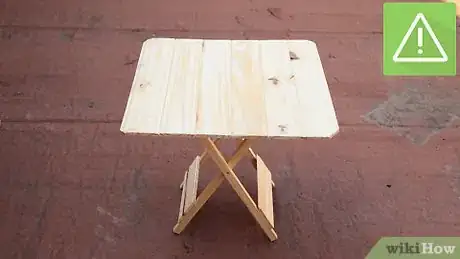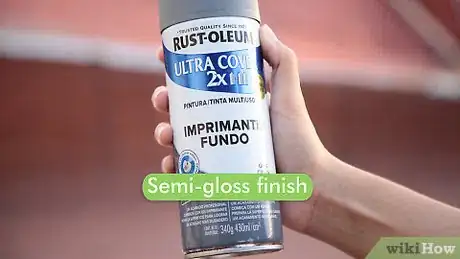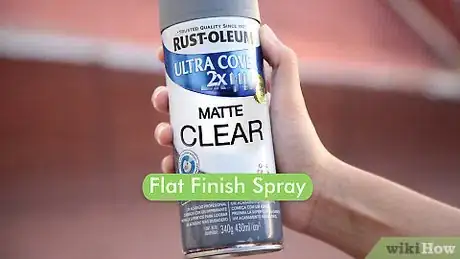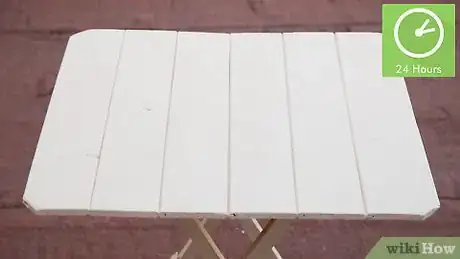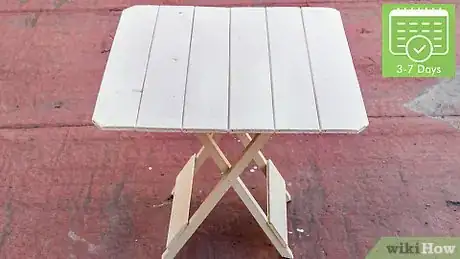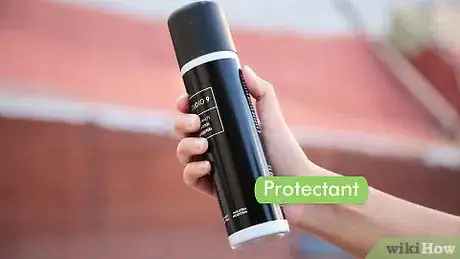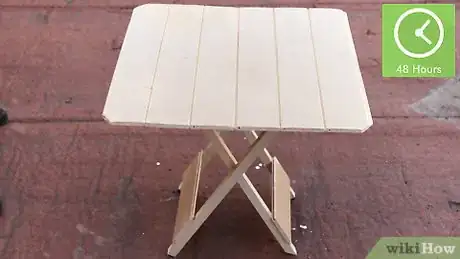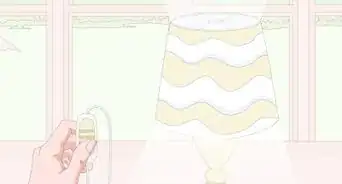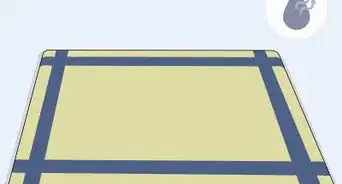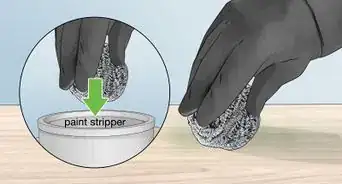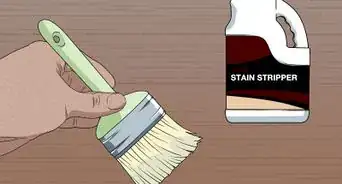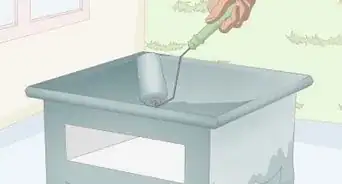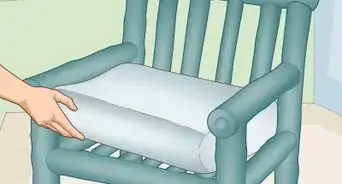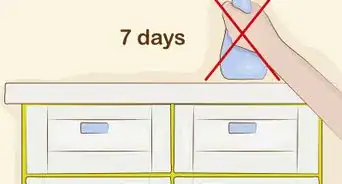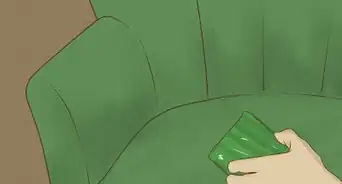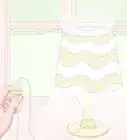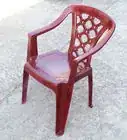This article was co-authored by Andres Matheu. Andres Matheu is the Owner of Hömm Certified Painting Systems, an Interior and Exterior Residential painting business based in the Washington, DC Metro area. Andres specializes in interior and exterior residential painting, color consultations, cabinet refinishing, wallpaper removal, and epoxy flooring among other services. An EPA Lead-safe Certified Firm, Hömm Certified Painting Systems has been awarded the Best of Houzz 2019 Service, Angie's List Super Service Award 2019, and Northern Virginia Magazine's 2018 Best Home Experts (painters) award.
There are 9 references cited in this article, which can be found at the bottom of the page.
This article has been viewed 53,829 times.
Painting is a great way to update an old table and cover up any imperfections. Although the process may seem daunting, it’s actually fairly straightforward. Start preparing the table’s surface by sanding, then apply a primer.[1] After the primer is dry, paint the table in a well-ventilated area and let it dry between each coat. Once the paint has dried, finish with a protectant formula to seal in the paint job. Let that layer dry, and your table is ready to be used!
Steps
Prepping the Table
-
1Separate any pieces that you don’t want stuck together. If your table has a leaf, pull it slightly open so the leaf doesn’t touch the edges of the main table. This way, the paint won’t seal the pieces together when it dries.
- If your table has no leaf, there’s no need to take pieces apart.[2]
-
2Sand down the tabletop to remove any thick varnish or imperfections.[3] Use an orbital sander with some medium-grit sandpaper to sand the top of the table smooth.[4] Go slowly and be careful not to gouge the surface. Don’t worry about removing all of the varnish, but sand down enough that the table isn’t too glossy and the primer will stick.[5]
- If your table is unvarnished, use 150-grit sandpaper to sand the table’s surface smooth.
- Always remember to wear protective gear when sanding. Before you begin, put on gloves, eye protection, and a mask.
Advertisement -
3
-
4Prime the table with roll-on/brush-on primer. Roll-on/brush-on formulas are best for high-traffic surfaces like tables, since they tend to be thicker and more durable than spray-on formulas. Apply 1 coat of primer with a mini foam roller or medium to small brush. Let that layer dry before applying a second coat and letting it dry as well.[8]
- Primer helps the paint stick to the wood and covers up any stains and discoloration.[9]
- Make sure to roll or brush the primer in the direction of the wood grain.[10]
- In between coats, wrap your roller or brush in a plastic bag and place it in the fridge. This will keep the paint moist and save you cleaning time in between layers.[11]
-
5Use spray-on primer to fill in hard-to-reach crevices. If your table has lots of inset details or crevices that are difficult to paint over, use a spray-on formula to fill these areas in.[12] This way, you’ll get an even base for the paint.
-
6Sand the surface by hand. To finish preparing the table for painting, sand the primed surface smooth with fine-grit sandpaper.[13] The orbital is too strong for the layer of primer, so sand gently by hand.
-
7Wipe the table down with a tack cloth. Clean away any dust or debris from sanding. In order for the paint to properly adhere, make sure that the table is completely clean and dry before you begin painting.
Applying Paint
-
1Find an open, well-ventilated area to paint. Choose an area with ventilation for paint fumes that won’t be in direct sunlight or affected by strong breezes. Make sure there’s enough room to walk around the table while painting.[14]
- Generally, temperatures from 55 to 70 °F (13 to 21 °C) are best for painting.[15]
-
2Select either an enamel-, latex-, or oil-based paint. All 3 look beautiful and are easily washable. However, they vary when it comes to durability and user-friendliness.
- Enamel-based paints are known for being hard, durable, rust-resistant, and easily washable.
- Latex-based paints are also easy to clean and look beautiful, but they don’t cure as well and are nowhere near as durable.
- Oil-based paints have a strong, unpleasant smell and must be cleaned up with special solvents, but they sink into the wood as they cure, making them extremely durable and easily washable.
-
3Choose a semi-gloss finish for high-traffic tables. Semi-gloss is best for kitchen tables because it’s tough, easy to clean, and hides fingerprints and smudges better than a flat-finish paint.
- If you choose a glossy finish, go for a semi-gloss indoor latex paint or a water-based enamel paint.[16]
-
4Choose a flat finish paint to cover up imperfections. Flat finishes work well for console tables or coffee tables because a smooth, matte finish hides any imperfections in the table’s textures. However, it is difficult to clean without damaging the paint job, so make sure not to use it on high-traffic surfaces.[17]
- If you’re not sure if you want flat or semi-gloss finish, start with a flat-finish paint. If you later decide that you prefer gloss, you can cover the flat paint with a satin or semi-gloss finish.[18]
-
5Apply a thin, even layer of paint over the entire table. Use a brush to paint any crevices first. Next, use a 4 in (10 cm) foam roller to apply a thin layer of paint to the table's flat surfaces. The foam roller will create a smooth, even finish without any brushstrokes. Be careful to avoid drips around the table’s edges and try to make the transition between brush and roller as level and smooth as possible.
-
6Let the paint dry for 24 hours. Waiting 24 hours will give the paint time to settle and adhere to the primed surface. Make sure the table dries in a shaded area so direct sunlight won’t affect the quality of the paint.
-
7Apply 2-3 more thin coats of paint and sand each coat by hand. Let each layer dry for 24 hours, then lightly sand and wipe down the surface before applying the next layer of paint. With some fine-grit sandpaper, gently sand down any drips and imperfection to even out the paint’s level. The orbital can be too strong for the primer and paint, so sand by hand to smooth and protect each layer.[21]
-
8Wipe down the surface with a tack cloth. After sanding, always wipe away dust and debris with a tack cloth. This will help you achieve a smooth, professional finish.[24]
-
9Let the paint cure for 3-7 days. Although the paint will feel dry to the touch in a day or 2, it actually needs 3-7 days to “cure,” or fully harden. This is especially important with oil- and enamel-based paints. If you don’t let the table cure long enough, it will be more prone to chipping and peeling.[25]
- Avoid touching the surface and keep it in a dry, shaded space while it cures.
Finishing the Tabletop
-
1
-
2Use finishing wax for lighter paint colors. Because finishing wax won’t alter your paint’s color, it works great over light colors. To apply it, dip a clean cotton cloth into some clear paste wax and apply it evenly over the table’s surface. Let it dry for at least an hour, then buff away the excess with a clean cloth or electric polisher. Repeat the process 3-4 times until you’ve built up a tough exterior.[28]
-
3Pair a polyurethane or polyacrylic finish with darker paint colors. These protectants work well on darker colors that can hold up against the finish’s slight color alteration. To apply either finish, lightly sand the tabletop with 320-grit sandpaper and wipe away any dust. Use a foam roller to apply a thin layer of protectant. Let it dry for 2 hours. Repeat this process 3-4 times.[29]
- Because these finishes tends to yellow over time, avoid using them over white or very light colors.[30]
- When applying the protectant with a foam roller, make sure to go slowly to prevent bubbles from forming.
-
4Let the finish cure for at least 48 hours. No matter which protectant you used, wait at least 2 full days before placing anything on the table. Disturbing the layers of while they’re curing could alter the topcoat’s strength, which is especially important on kitchen tables.[31]
- You should also wait 1 week before using any cleaning products or chemicals on the table.
Expert Q&A
-
QuestionWhat paint should I use if I would like to paint my table black?
 Andres MatheuAndres Matheu is the Owner of Hömm Certified Painting Systems, an Interior and Exterior Residential painting business based in the Washington, DC Metro area. Andres specializes in interior and exterior residential painting, color consultations, cabinet refinishing, wallpaper removal, and epoxy flooring among other services. An EPA Lead-safe Certified Firm, Hömm Certified Painting Systems has been awarded the Best of Houzz 2019 Service, Angie's List Super Service Award 2019, and Northern Virginia Magazine's 2018 Best Home Experts (painters) award.
Andres MatheuAndres Matheu is the Owner of Hömm Certified Painting Systems, an Interior and Exterior Residential painting business based in the Washington, DC Metro area. Andres specializes in interior and exterior residential painting, color consultations, cabinet refinishing, wallpaper removal, and epoxy flooring among other services. An EPA Lead-safe Certified Firm, Hömm Certified Painting Systems has been awarded the Best of Houzz 2019 Service, Angie's List Super Service Award 2019, and Northern Virginia Magazine's 2018 Best Home Experts (painters) award.
Commercial Painter When painting a table black, I would use a black enamel with a semi-gloss finish. It's gonna be glossy, but enamels perform better when it comes to furniture.
When painting a table black, I would use a black enamel with a semi-gloss finish. It's gonna be glossy, but enamels perform better when it comes to furniture. -
QuestionIs it better to use a small foam or fluffy roller to do a kitchen table top?
 Community AnswerIt depends on the type of the table/counter top. If it's marble then use a small foam roller and then glaze it, but if it's plastic, use a fluffy roller.
Community AnswerIt depends on the type of the table/counter top. If it's marble then use a small foam roller and then glaze it, but if it's plastic, use a fluffy roller.
Things You’ll Need
- Medium-grit sandpaper
- Fine-grit sandpaper
- Orbital sander
- Tack cloths
- Roll-on/brush-on primer
- Spray-on primer (for corners and crevices)
- Foam roller or bristle brush
- Paint
- Protectant/wax finish
- Dust mask
- Protective gear
Warnings
- Always paint in a well-ventilated area.⧼thumbs_response⧽
- To protect yourself from inhaling dust and paint fumes, make sure to wear a dust mask while you work--particularly while sanding.[33]⧼thumbs_response⧽
References
- ↑ Andres Matheu. Commercial Painter. Expert Interview. 28 July 2020.
- ↑ https://www.erinspain.com/how-to-paint-furniture-a-beginners-guide/
- ↑ Andres Matheu. Commercial Painter. Expert Interview. 28 July 2020.
- ↑ https://www.erinspain.com/how-to-paint-furniture-a-beginners-guide/
- ↑ https://centsationalstyle.com/2012/03/painting-a-kitchen-table/
- ↑ http://www.countryliving.com/diy-crafts/tips/a266/paint-furnishings-and-learn-from-my-mistakes/
- ↑ Andres Matheu. Commercial Painter. Expert Interview. 28 July 2020.
- ↑ https://centsationalstyle.com/2012/03/painting-a-kitchen-table/
- ↑ https://www.realsimple.com/home-organizing/decorating/decorating-tips-techniques/how-to-paint-unfinished-wood-furniture
- ↑ https://www.realsimple.com/home-organizing/decorating/decorating-tips-techniques/how-to-paint-unfinished-wood-furniture
- ↑ https://www.realsimple.com/home-organizing/decorating/decorating-tips-techniques/how-to-paint-unfinished-wood-furniture
- ↑ https://centsationalstyle.com/2012/03/painting-a-kitchen-table/
- ↑ Andres Matheu. Commercial Painter. Expert Interview. 28 July 2020.
- ↑ https://www.lowes.com/creative-ideas/paint-stain-and-wallpaper/paint-wood-furniture/project
- ↑ https://centsationalstyle.com/2012/03/painting-a-kitchen-table/
- ↑ http://www.countryliving.com/diy-crafts/tips/a266/paint-furnishings-and-learn-from-my-mistakes/
- ↑ http://homeguides.sfgate.com/recommended-paint-finishes-furniture-100339.html
- ↑ https://www.realsimple.com/home-organizing/decorating/decorating-tips-techniques/how-to-paint-unfinished-wood-furniture
- ↑ https://www.lowes.com/creative-ideas/paint-stain-and-wallpaper/paint-wood-furniture/project
- ↑ https://www.lowes.com/creative-ideas/paint-stain-and-wallpaper/paint-wood-furniture/project
- ↑ https://www.lowes.com/creative-ideas/paint-stain-and-wallpaper/paint-wood-furniture/project
- ↑ https://www.erinspain.com/how-to-paint-furniture-a-beginners-guide/
- ↑ https://www.lowes.com/creative-ideas/paint-stain-and-wallpaper/paint-wood-furniture/project
- ↑ https://www.erinspain.com/how-to-paint-furniture-a-beginners-guide/
- ↑ http://homeguides.sfgate.com/hard-finish-tabletop-after-painting-49108.html
- ↑ Andres Matheu. Commercial Painter. Expert Interview. 28 July 2020.
- ↑ https://www.erinspain.com/how-to-paint-furniture-a-beginners-guide/
- ↑ http://homeguides.sfgate.com/hard-finish-tabletop-after-painting-49108.html
- ↑ http://homeguides.sfgate.com/hard-finish-tabletop-after-painting-49108.html
- ↑ http://homeguides.sfgate.com/hard-finish-tabletop-after-painting-49108.html
- ↑ http://homeguides.sfgate.com/hard-finish-tabletop-after-painting-49108.html
- ↑ https://www.lowes.com/creative-ideas/paint-stain-and-wallpaper/paint-wood-furniture/project
- ↑ https://centsationalstyle.com/2012/03/painting-a-kitchen-table/
About This Article
To paint a table, start by sanding down the tabletop to remove any varnish or imperfections. Next, apply 1 coat of primer, allow it to dry, then apply a second coat to help the paint stick to the wood. Once the primer is dry, sand the primed surface to smooth it out. Then, pick an enamel, latex, or oil-based paint and apply a thin, even layer over the entire table. After allowing it to dry for 24 hours, apply 2 to 3 more coats of paint, sanding each as you go. Finally, allow the paint to cure for 3 days before applying a finishing protectant. To learn how to use a finishing wax for lighter paint colors, keep reading!

